Part one
Photographers Martha Cooper and Katherine Lorimer aka Luna Park are two of the most important documenters of post-1960’s street art and graffiti. While both are still photographing today, they represent two generations of graffiti and street art documentation.
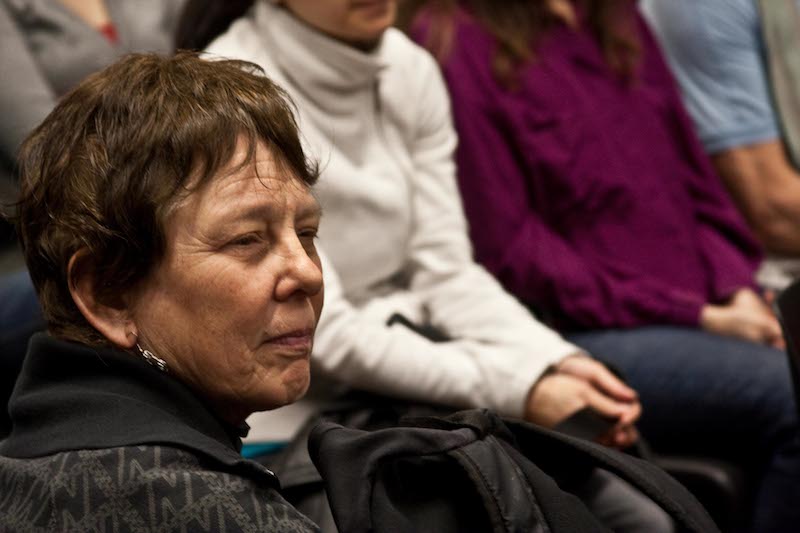
Martha Cooper in 2010. Photo courtesy of the New York Council for the Humanities.
A photojournalist with a background in anthropology, Cooper began documenting street art and graffiti in the 1970’s and eventually collaborated with Henry Chalfant on Subway Art (1984), a book of their photographs of graffiti and the most influential book ever published about graffiti. Today, with half a dozen more books on graffiti and hip hop culture under her belt, Cooper continues to photograph street art and graffiti, with a focus on works-in-progress. She has taken to Instagram for sharing many of her photos, including more general street photography.
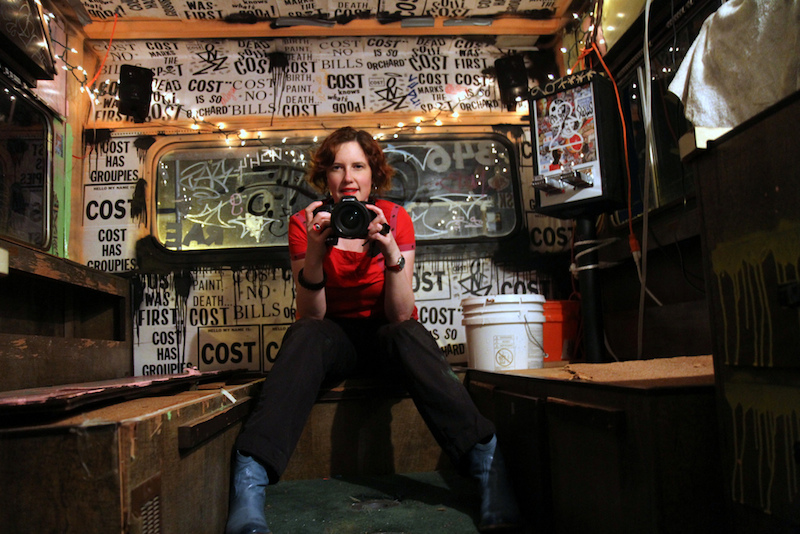
Katherine Lorimer aka Luna Park in 2009. Photo by Becki Fuller.
Lorimer has been taking photos of street art and graffiti and posting them to Flickr since early 2005. Although Lorimer’s photographs have appeared in books, she has not yet released a book of her photographs. Most of Lorimer’s fans see her work online on her Flickr, blog or Instagram. Photography has never been her day job and documenting the streets has always been purely a hobby for Lorimer, but she has become one of the most respected photographers of contemporary New York street art and graffiti. Lorimer is known for her beautiful shots, knowledge of the New York City street art and graffiti scenes and commitment to documenting the best work on the streets at any given time.
One evening during the summer of 2012, I sat down with Cooper and Lorimer to discuss their lives, their work and street art and graffiti in general. Here is an edited version of that conversation:
Katherine Lorimer: Martha, I was looking over your Wikipedia entry last night. I didn’t know that you had a background in anthropology. I also have that background, so I was wondering if that has informed your interest in subcultures such as graffiti?
Martha Cooper: Absolutely. I wanted to have a career in the museum anthropology, or museum art. I was a curatorial assistant at Yale in anthropology, and I used to shoot archaeology assignments for National Geographic. But when I looked at getting a PhD in anthropology, it looked too difficult and not really something I wanted to do. I wanted to work in the field. I wanted to see the African masks in action, rather than in the museum environment. So I married an anthropologist, he did his fieldwork in Japan, and I went with him to Japan. I was interested in everyday art. Art in its environment, not in museums. It’s what I shot in Japan in 1970, Japanese hand tattooing. It required getting into the scene similarly to how I got into graffiti.
Lorimer: Gaining the confidence of the community?
Cooper: Yeah, gaining their confidence et cetera. I’m surprised to hear that you also have a background in anthropology.
Lorimer: I have an undergraduate degree in anthropology and German. Career-wise, it was the same thing for me – I had thought about doing a PhD in anthropology, but ultimately decided against it. Part of what interested me, once I learned more about graffiti and street art, was that it is a subculture with rules for how people interact, what you can and can’t do, with unique concepts of fame, respect and hierarchy. How all these things play together is fascinating to me.
RJ Rushmore: I’m curious about how each of you gained entry into the street art and graffiti cultures, which I think we can safely say are two different but overlapping cultures.
Lorimer: In my case, it was all over the internet, which is obviously a very different experience from Martha’s. To this day, there are many artists whom I’ve never met, but we know each other through social media, Flickr, blogs… and I’ve e-mailed with a lot of people before ever meeting them, so it’s a very strange situation sometimes to meet people whose work I’ve been following for years, people I’ve corresponded with. It can be awkward, but in most cases there is a certain comfort level immediately after we meet one another that I don’t think would be possible if we didn’t have the technology to make these connections.
Cooper: Didn’t Just stay with you when he came over? And first he stayed here. When he left, he said, “Now, I’m going over to Luna’s.” But he had never met you, right?
Lorimer: No, but there are all these networks, and I think that social media just makes it easier for people to make these connections. I know people in Berlin, so whenever people from Berlin come over here, they all say, “Look up Luna. Because A. She speaks German, and B. She knows A, B and C.” But I’m curious what your experiences were like. Today, people will send me a text or an email, and I’ll know, in some cases minutes after a piece goes up, because of the technology. Whereas, for you, what was the process like?
Cooper: Telephone. The process of getting in was that I was working for the New York Post as a staff photographer and every day going through the Lower East Side and using up my rolls of films. I shot a project on kids’ creative play. They had to be building something or making something, so really it was like children’s folk art. I met a boy, HE3, and he showed me his book, and he had been flying pigeons, so I saw him more than once. He said, “Why don’t you take pictures of graffiti?” He showed me that he was designing his name to put on a wall, and it just clicked. I didn’t know that graffiti was nicknames. It had always been a bit disappointing. You’d see something, but it didn’t make any sense. It was just a collection of letters. It wasn’t generally known that these were nicknames, and so he really got me into it and he introduced me to DONDI. Before I went to look at trains, I spent time interviewing DONDI. I took a friend, the photo editor from the New York Post, with me, and she shot this photo of me interviewing DONDI in DONDI’s basement. I interviewed him as much about pigeon flying as about painting. I wasn’t only interested in graffiti, and I shot these pictures in his room of DONDI and his friends designing in a black books way before I seriously looked at trains. I didn’t even understand that there were wholecars or anything. Remember, at any one time maybe there was only one wholecar running on a line. I hadn’t been looking. The looking came later. I got in through this circuitous children’s play idea that I had.
RJ: It’s interesting to me how sometimes people think that Vandalog is my day job. I go to college, and I’m a political science major. I have friends who don’t care about art. Does that sort of thing happen to you where people assume that this is your day job or your only interest?
Cooper: Yes.
Lorimer: Sure.
RJ: Is that something that you simply accept or something that you try to dispel in some way?
Lorimer: People only know the public part of me, which is what I choose to share online, and are often very surprised when I say that I work a full-time job as a librarian, I travel for work and I do other things. I think people just see me online and have this kind of romantic notion that I’m the torchbearer for the next generation or something like that.
Cooper: I don’t want to be considered a graffiti photographer, or a street art photographer. So if somebody actually calls me that to my face, I’m going to correct them. Of all the pictures I’ve taken, those just happen to be the pictures that people know about. I’m very grateful for all the places that I’ve had the opportunity to go because of graffiti, and all the friends that I’ve made because of graffiti. That’s given me the kind of life I never could’ve had otherwise, but I don’t perceive myself as a graffiti photographer. And I don’t want to be thought of as some kind of graffiti historian, because I only know what I saw. I wind up having to apologize for all of the things that I didn’t see.
Lorimer: I can only talk about what I know, which is the last eight years. Within the larger history of graffiti, that’s a drop in the bucket. I’m a newbie. One of the biggest differences between Martha and I is that Martha has an entire history of being a photojournalist who has shot all kinds of subject matters, and I’m not a professional photographer. I’m an amateur photographer. If anything, the experience of shooting for the last eight years was sort of a creative awakening for me. I enjoy shooting, but it’s not everything that I do.
Cooper: I only want to shoot process. I want to see how people do it. That might be the anthropologist in me. I want to see what stencils they use. I want to see if they use a roller. In Baltimore, Jaz had this contraption of 2 brushes at 2 different angles, and I took pictures and close-ups of that. I like seeing all the creative ways artists figure out how to work. Besides, everybody with a phone can take a photo of the finished walls.
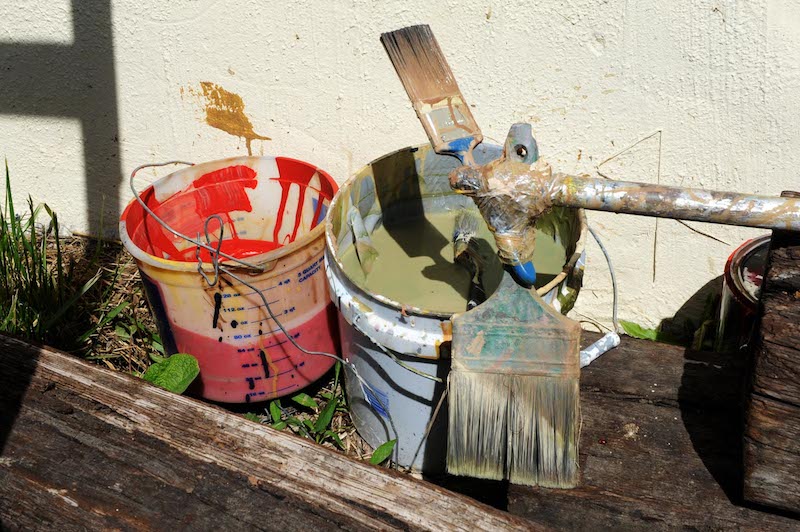
Jaz’ brush contraption in Baltimore, MD. Photo by Martha Cooper.
Lorimer: There’s not any point in trying to be the 1st to get a flick anymore because it’s a losing battle. Everyone is a photographer these days. The landscape of street art photography has even changed in the last seven or eight years since I started. All these blogs, including Vandalog, didn’t exist when I first started, whereas now there’s a huge street art blogosphere/media just waiting to suck up whatever photos they can get their hands on first and blast them out into the internet. Sometimes I feel like the photos are merely fodder for this never-ending content-consuming beast that is the internet. People look at it once and it’s like “That’s cool,” and then it’s next, next next, next, next…
Cooper: And as I said, I really want to see work in progress. That just takes place over one or two days, so if somebody doesn’t tell me and I don’t know about it, I’m not going to run out and try to catch that finished wall. The writers used to call me and tell me if their pieces were on the morning or the afternoon side of the train, because the two’s went back and forth without turning around. The one’s turned around. If you waited on the same side for three hours in the morning, you would see both sides of the train. The two’s go out to New Lots and back, but they don’t turn, so if you were on the wrong side, you’d never get to see the piece. And the kids learned to tell me to go out in the morning or the afternoon, because you don’t really want a backlit train. You want the sun hitting the train.
Lorimer: A lot of the time, it’s just a matter of being there for good light. The best tips are the ones that say “come by in the afternoon,” or “best light in the morning,” because otherwise it’s a waste of my time.
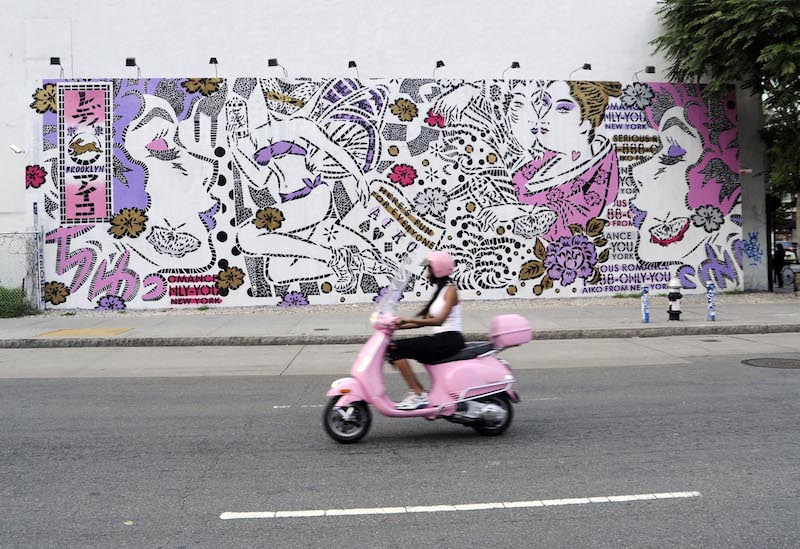
Aiko Nakagawa’s mural on the wall at Bowery and Houston in New York City. Photo by Martha Cooper.
Cooper: Yeah, you could go and there would be a big shadow diagonally across the wall. The Houston Street wall has a big shadow problem if you don’t come at the right time of day. For me, the challenge is to take a good picture, and I think people don’t understand that I’m at least as much interested in my photography as in the wall. I want the artist to like the picture too, but for me it’s really hard to get an unusual and interesting photo of somebody painting a wall. Or just the wall. I think Just is really a good photographer. Sometimes I see pictures that he’s taken and I’m jealous because he’ll nail it. So I’m looking at it from a photographer’s point of view, and not only from whether it’s a good wall. I’m at least as interested in its being a good picture. Is it the same for you, Luna?
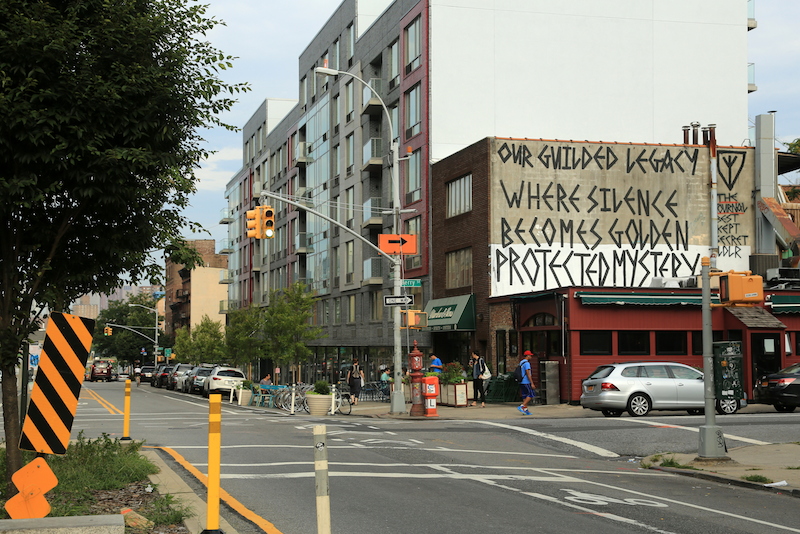
RAMBO in Brooklyn with plenty of context. Photo by Luna Park.
Lorimer: It’s getting there. I feel like I’m learning to hone my craft as a photographer as I go along. I go back to what I shot in 2005, and it was tightly cropped detail shots, which though interesting for the historical record, is not so interesting as a photo showing more context.
Cooper: Although the artists tend to like those.